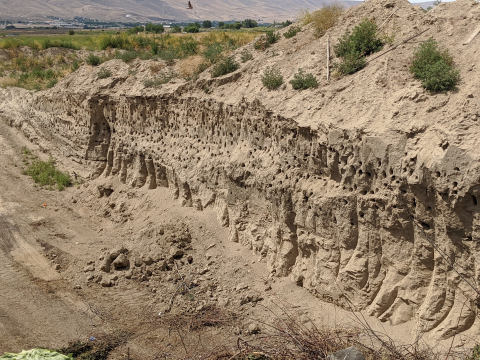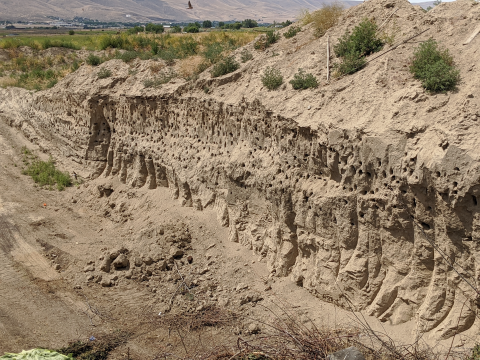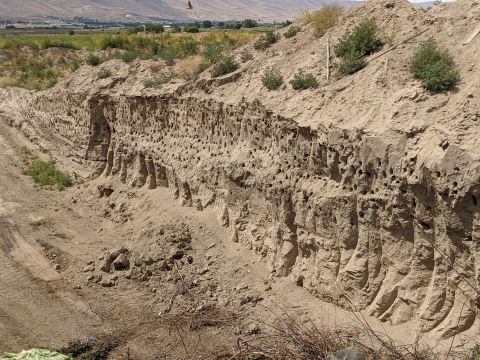Complete replicate terabase metagenome (TmG.2.0) of grassland soil microbiome collections from KPBS field site in Manhattan, KS. Metagenome (unclassified soil sequencing) Data DOI Package, version 2.0.
Filter results
Category
- (-) Biology (258)
- (-) Energy Resiliency (12)
- Scientific Discovery (369)
- Earth System Science (161)
- Human Health (112)
- Integrative Omics (73)
- Microbiome Science (47)
- National Security (31)
- Computational Research (25)
- Computing & Analytics (17)
- Chemical & Biological Signatures Science (12)
- Weapons of Mass Effect (12)
- Chemistry (10)
- Data Analytics & Machine Learning (9)
- Computational Mathematics & Statistics (7)
- Materials Science (7)
- Atmospheric Science (6)
- Data Analytics & Machine Learning (6)
- Renewable Energy (6)
- Visual Analytics (6)
- Coastal Science (4)
- Ecosystem Science (4)
- Energy Storage (3)
- Plant Science (3)
- Solar Energy (3)
- Bioenergy Technologies (2)
- Cybersecurity (2)
- Distribution (2)
- Electric Grid Modernization (2)
- Energy Efficiency (2)
- Grid Cybersecurity (2)
- Transportation (2)
- Computational Mathematics & Statistics (1)
- Grid Analytics (1)
- High-Performance Computing (1)
- Subsurface Science (1)
- Terrestrial Aquatics (1)
- Wind Energy (1)
Tags
- Virology (77)
- Immune Response (51)
- Time Sampled Measurement Datasets (51)
- Differential Expression Analysis (46)
- Gene expression profile data (45)
- Homo sapiens (42)
- Predictive Phenomics (34)
- Mass spectrometry data (32)
- Multi-Omics (32)
- Viruses (27)
- Omics (25)
- Health (23)
- Mass Spectrometry (23)
- Soil Microbiology (23)
- Virus (23)
- MERS-CoV (19)
- Mus musculus (19)
- Proteomics (18)
- sequencing (13)
- West Nile virus (13)
- Genomics (12)
- High Throughput Sequencing (11)
- Influenza A (11)
- TA2 (11)
- Metagenomics (10)
- PerCon SFA (10)
- S. elongatus PCC 7942 (10)
- TA1 (10)
- Ebola (9)
- Microbiome (8)
Complete replicate terabase metagenome (TmG.2.0) of grassland soil microbiome collections from IAREC field site in Prosser, WA. Metagenome (unclassified soil sequencing) Data DOI Package, version 2.0.
Category
Complete replicate terabase metagenome (TmG.2.0) of grassland soil microbiome collections from COBS field site in Boone County, IA. Metagenome (unclassified soil sequencing) Data DOI Package, version 2.0.
Category
The OSU/PNNL Superfund Research Program (SRP) represents a longstanding collaboration to quantify Polycyclic Aromatic Hydrocarbons (PAHs) at various superfund sites in the Pacific Northwest and assess their potential impact on human health. To link the chemical measurements to biological activity...
Category
Systems Virology Lethal Human Virus, SARS-CoV Experiment SHAE003 New uploads pending The purpose of this SARS experiment was to obtain samples for transcriptome analysis in Human Airway Epithelial (HAE) cells infected with SARS-CoV, SARS deltaORF6, SARS BatSRBD mutants in a longitudinal study...
Category
Systems Virology Lethal Human Virus, SARS-CoV Experiment SHAE002 New uploads pending The purpose of this SARS experiment was to obtain samples for transcriptome analysis in Human Airway Epithelial (HAE) cells infected with SARS-CoV, SARS deltaORF6, SARS BatSRBD mutants in a longitudinal study...
Category
Systems Virology Lethal Human Virus, SARS-CoV Experiment SCL012 New uploads pending The purpose of this SARS experiment was to obtain samples for metabolome and lipidome analysis comparing wild type virus (icSARS) vs icSARS CoV deltaORF6 infected Human lung tissue 2B4 (Calu-3 clonal derivative)...
Category
Systems Virology Lethal Human Virus, SARS-CoV Experiment SCL009 New uploads pending The purpose of this SARS experiment was to obtain samples for metabolome and lipidome analysis comparing wild type virus (icSARS) infected Human lung tissue 2B4 (Calu-3 clonal derivative) cells to mock infected cells...
Category
Systems Virology Lethal Human Virus, SARS-CoV Experiment SCL008 New uploads pending The purpose of this SARS experiment was to obtain samples for transcriptome and proteome analysis in human lung 2B4 cells (clonal derivative of Calu-3 cells) infected with either icSARS CoV, icSARS-deltaNSP16 or...
Category
Systems Virology Lethal Human Virus, SARS-CoV Experiment SCL006 New uploads pending The purpose of this SARS experiment was to obtain samples for transcriptome and proteome analysis in human lung 2B4 cells (clonal derivative of Calu-3 cells) infected with wild type icSARS CoV Urbani and icSARS Bat...
Category
Systems Virology Lethal Human Virus, SARS-CoV Experiment SCL005 New uploads pending The purpose of this experiment was to evaluate the human host response to wild type virus icSARS-CoV Urbani and mutant virus icSARS deltaORF6 (DORF6) infection for subsequent transcriptional and proteomic analysis in...
Category
Systems Virology Lethal Human Virus, SARS-CoV Experiment SM012 New uploads pending The purpose of this SARS experiment was to obtain samples for transcriptome and proteome analysis in C57Bl/6 mice infected with SARS MA15 or SARS deltaORF6 mutant viruses. Overall Design: Twenty-week-old C57BL/6 mice...
Category
Systems Virology Lethal Human Virus, SARS-CoV Experiment SM003 New uploads pending The purpose of this SARS experiment was to obtain samples for transcriptome and proteome analysis in C57BlL/6 mice lung infected with dicSARS CoV, SARS MA15 wild type and SARS BatSRBD mutant virus. Overall Design...
Category
Omics Lethal Human Virus, SARS-CoV Experiment SM001 New uploads pending The purpose of this experiment was to evaluate the human host response to Severe Acute Respiratory Syndrome coronavirus (SARS-CoV) wild-type virus. Sample data was obtained for 20 week-old C57BL/6J mouse lung tissue infected...
Category
Last updated on 2024-02-11T22:41:43+00:00 by LN Anderson West Nile Virus Experiment WSE001 The purpose of this experiment was to evaluate the host response to West Nile virus (strain WNV-NY99) wild-type clone 382 virus infection. Sample data was obtained from mouse (strain C57BL6/JAX) blood serum...





